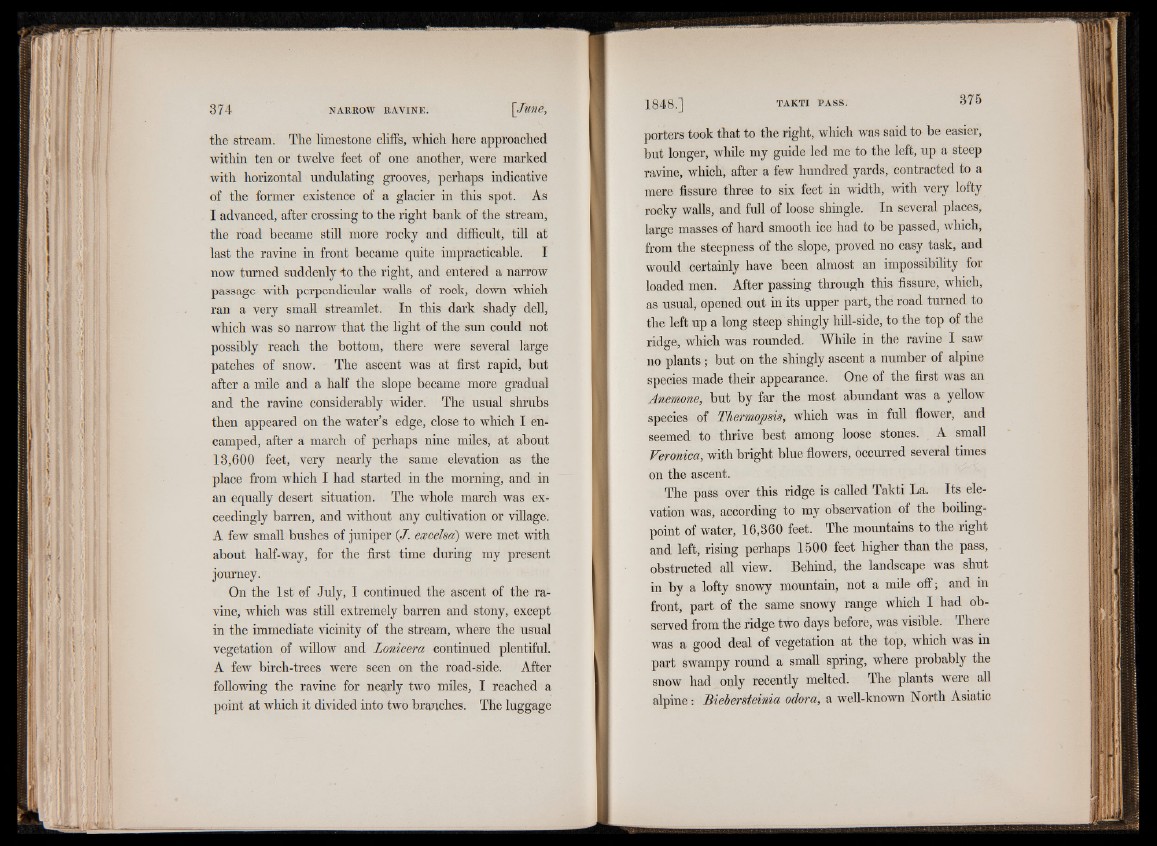
the stream. The limestone cliffs, which here approached
within ten or twelve feet of one another, were marked
with horizontal undulating grooves, perhaps indicative
of the former existence of a glacier in this spot. As
I advanced, after crossing to the right bank of the stream,
the road became still more rocky and difficult, till at
last the ravine in front became quite impracticable. I
now turned suddenly -to the right, and entered a narrow
passage with perpendicular walls of rock, down which
ran a very small streamlet. In this dark shady dell,
which was so narrow that the light of the sun could not
possibly reach the bottom, there were several large
patches of snow. The ascent was at first rapid, but
after a mile and a half the slope became more gradual
and the ravine considerably wider. The usual shrubs
then appeared on the water’s edge, close to which I encamped,
after a march of perhaps nine miles, at about
13,600 feet, very nearly the same elevation as the
place from which I had started in the morning, and in
an equally desert situation. The whole march was exceedingly
barren, and without any cultivation or village.
A few small bushes of juniper (J. excelsa) were met with
about half-way, for the first time during my present
journey.
On the 1st of July, I continued the ascent of the ravine,
which was still extremely barren and stony, except
in the immediate vicinity of the stream, where the usual
vegetation of willow and Lonicera continued plentiful.
A few birch-trees were seen on the road-side. After
following the ravine for nearly two miles, I reached a
point at which it divided into two branches. The luggage
porters took that to the right, which was said to be easier,
but longer, while my guide led me to the left, up a steep
ravine, which, after a few hundred yards, contracted to a
mere fissure three to six feet in width, with very lofty
rocky walls, and full of loose shingle. In several places,
large masses of hard smooth ice had to be passed, which,
from the steepness of the slope, proved no easy task, and
would certainly have been almost an impossibility for
loaded men. After passing through this fissure, which,
as usual, opened out in its upper part, the road turned to
the left up a long steep shingly hill-side, to the top of the
ridge, which was rounded. While in the ravine I saw
no plants; but on the shingly ascent a number of alpine
species made their appearance. One of the first was an
Anemone, but by far the most abundant was a yellow
species of Thermopsis, which was in full flower, and
seemed to thrive best among loose stones. A small
Veronica, with bright blue flowers, occurred several times
on the ascent.
The pass over this ridge is called Takti La. Its elevation
was, according to my observation of the boiling-
point of water, 16,360 feet. The mountains to the right
and left, rising perhaps 1500 feet higher than the pass,
obstructed all view. Behind, the landscape was shut
in by a lofty snowy mountain, not a mile off; and in
front, part of the same snowy range which I had observed
from the ridge two days before, was visible. There
was a good deal of vegetation at the top, which was in
part swampy round a small spring, where probably the
snow had only recently melted. The plants were all
alpine: Biebersteinia odor a, a well-known North Asiatic